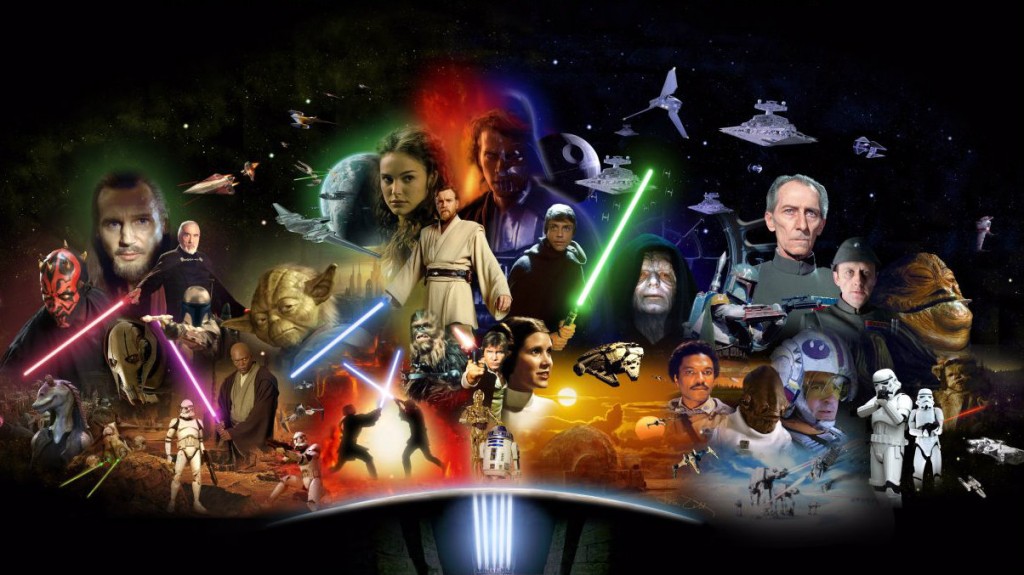
“If you see them in order it completely twists things about. A lot of the tricks of IV, V and VI no longer exist…Part of the fun for me was completely flipping upside down the dramatic track of the original movies. If you watch them the way it was released, IV, V, VI, I, II, III -- you get one kind of movie. If you watch I through VI you get a completely different movie. One or two generations have seen it one way, and the next generation will see it in a completely different way.”
-- George Lucas, 2005
In making the Prequels, George Lucas assumed, as did fans of the original STAR WARS trilogy, that the order in which the series would be viewed would change. The series would naturally be watched in narrative chronology rather than in the order of release. This isn’t an unreasonable expectation; STAR WARS, EMPIRE and JEDI were always the second half of a promised saga, after all. However, the preservation of plot twists and the uniqueness of the narrative structure became a source of contention amongst audiences once the entire story was finally told. Because so much of what gives the Original Trilogy its power is the development of the Skywalker backstory, the question is raised when introducing a Newbie to the series: where do we start...?
There’s no easy answer here, given the divided nature of viewers in regards to STAR WARS as a franchise. Lucas was correct in many ways: it is a generational thing. The kids of my era experienced the Original Trilogy first, which became the barometer by which the rest of the movies, books, games, comics, and associated materials were judged. By that same token, Millennials got Jar Jar and midichlorians and CLONE WARS cartoons and Legos; that’s “STAR WARS” to them. Now, thanks to Disney, there’s a third subsection of fans; because if the number of small children in attendance is any indication, my son’s peers will grow up associating Rey, Finn, BB-8 and Kylo Ren with STAR WARS the way I do with Luke, Han, Leia, and R2-D2. STAR WARS is unique in both its longevity and the devotion its fans show it, and each decade breeds a new audience with its own specific attachments.
As of this writing, my son is going on seven. He’s seen the original three films, and THE FORCE AWAKENS. He got to see THE LAST JEDI in the theaters (and he considers it both too long, and too scary). His favorite was EMPIRE for a while because he loves watching Luke use the Force to cut himself down from the ceiling in the Wampa’s cave, and he thinks Yoda is hysterical. It's pretty simple for him: he wants the speeder bike chase today and Jawas tomorrow. He’s a bit young for me to insist upon a viewing order, even within the framework of scene-skipping.
But what about when he’s a little older…? What about for new viewers coming to STAR WARS for the first time? What movie do you start with? Which ones "count" and which ones don't? As a wise old liar once said, "You're going to find that many of the truths we cling to depend greatly on our own point of view."
As far as I see it, here are the options.
1. ORIGINAL TRILOGY ONLY. For some people, this is “pure” STAR WARS: an episodic adventure with a distinct beginning, middle and end. Theatrical editions only; no SPECIAL EDITION nonsense. Requires laserdiscs, VHS, or bootlegs. Prior to Christmas 2015, I was firmly in this camp.
2. ORIGINAL TRILOGY AND SEQUEL TRILOGY. Yes, I dig THE FORCE AWAKENS, so this is me. Original theatrical cuts of STAR WARS, EMPIRE, and JEDI, followed by AWAKENS and LAST JEDI. Unless Abrams spectacularly drops the ball on RISE OF SKYWALKER, I’ll take my saga in a six-pack, please.
3. PREQUELS, ORIGINAL TRILOGY (SPECIAL EDITIONS), AND SEQUELS/DISNEY ONE-SHOTS. Basically, “all of them.” Note that the SPECIAL EDITIONS become a requirement here if you’re expecting the films to contain narrative harmony.
4. PREQUEL TRILOGY AND ORIGINAL TRILOGY (SPECIAL EDITIONS). This is for the hardcore Prequel fans who defend the derided works of George Lucas and apparently despise the non-Lucas efforts of Disney.
Now, look, I’m as aware as anyone else that what we’re discussing here is Hardcore Nerd Stench. The average person doesn’t give a shit about SPECIAL EDITIONS or when this specific movie was made, or whatever else; to most people, STAR WARS is STAR WARS. It’s all just one big thing, currently made up of eight episodes and some sidequals. While I might reject the Prequels and the computer-molested versions of the Original Trilogy on sale at Best Buy, a lot of people don’t. They’re probably a lot happier in their lives for it, and dedicate the intense passion I waste on STAR WARS for something meaningful, like football.
So with all that said, let’s just stop being precious for a moment and accept it all. All eight movies, plus ROGUE ONE and SOLO. They’re all STAR WARS films and tell one big story, warts and all. We keep coming back around to the central question: in what order do we watch them?
I propose the following, each with their own unique identity. These have been derived from numerous online discussions since the release of SITH. For the time being, we’ll concentrate on the six films produced by George Lucas, given that the Sequels have not yet told their full story and can't be assessed in the same fashion (and the sidequals are just that).
A. NARRATIVE ORDER. We see the events of the Skywalker family play out. What were once shocking plot twists in EMPIRE and JEDI become payoffs to the equally shocking events in SITH: notably, our protagonist becoming the antagonist for the second half of the series. We worry about Luke’s Sith-like tendencies (anger, impatience) and seriously worry what’s going to happen when he, like his father, acts irresponsibly in the face of premonitions. Plus, we get to squirm uncomfortably when Luke and Leia kiss.
B. CHRONOLOGICAL ORDER. Watching the films in order of release preserves the twists inherent in the Original Trilogy, and then allows us to fully appreciate the tragic nature of the Prequels. Because we know how it all turns out, we watch helplessly as Anakin makes choices that we know end in death, loss, and his kids making out with one another.
C. EPISODES III - VI. By skipping MENACE and CLONES, one can get straight to the drama in SITH (which is where 80-percent of the Prequel story takes place, anyway), and then go directly into the Original Trilogy. For Prequel Haters, this is the "Diet" soda.
D. RHYMING ORDER. Lucas is (in)famously quoted as declaring that each film in the Prequel Trilogy visually and thematically “rhymed” with its counterpart in the Original Trilogy: thus MENACE = STAR WARS, CLONES = EMPIRE, and SITH = JEDI. Even the titles are similar, albeit with their meanings inverted. Thus, one can technically preserve the shocking plot twists in the Prequels AND the original films by watching them like this: MENACE, STAR WARS, CLONES, EMPIRE, SITH, and then JEDI. We can continue to believe that a “young Jedi named Darth Vader” will be showing up somewhere in the backstory, and then be surprised when Vader declares his parentage in EMPIRE. This leads directly into SITH, where the truth is told, and then ultimately resolved in JEDI. Jumping back in forth along the timeline makes STAR WARS a non-linear (but parallel) experience a la Tarantino, Nolan, and Erik Kristopher Myers.
E. FLASHBACK ORDER. As with the Rhyming Order, Flashback Order is also designed to preserve the Original Trilogy’s plot twists, but without the back-and-forth cross-cutting between the two sets of films. In this case, the Prequels are treated, as the name suggests, as an extended flashback. The order would go: STAR WARS and EMPIRE, then MENACE, CLONES, SITH, and back to JEDI. Once Vader reveals his identity to Luke, and he -- along with the audience -- is left guessing, we go into the Prequels. When viewed this way, there’s still hope that Vader lied and that the Anakin we meet will die heroically rather than become the villain.
If there’s one thing Lucas is right about, it’s that the STAR WARS series now becomes experimental in terms of how it’s watched. “It’s an extremely modern, almost interactive moviemaking” he said in 2005. “You take blocks and move them around, and you come out with different emotional states.” This is probably the bright spot to come out of the problematic existence of the Prequels, which, due to their very content, retroactively harm many of the elements we like best about the first series, EMPIRE in particular.
Given Disney’s decision to make spin-off films taking place outside of the “saga” films, the dreadfully-named STAR WARS STORY installments raise all sorts of new questions in terms of sequencing. The first of the bunch, ROGUE ONE, takes place between SITH and STAR WARS; is follows the “death” of Anakin Skywalker with an unrelated heist movie helpful or detrimental to the overarching drama? SOLO is equally problematic, as it’s another prequel (!) that interrupts the primary narrative with a standalone adventure.
Which STAR WARS “counts”? Ask different people and they’ll give you different answers. As already stated, the average viewer will tell you “All of it.” Hardcore fans are splintered; some say this part, others say that part; still yet others with entirely too much time on their hands (and a far stronger tolerance for garbage than I have) include every single book, cartoon, and ancillary tie-in that’s make it past the often dubious quality control department of Lucasfilm. It becomes weird to consider that the films on which the franchise is built are simply isolated stories within a much larger tapestry of bad sci-fi.
In the end, the simple answer becomes: Watch the ones you like, in the order you like.
But being STAR WARS, nothing is simple.
Erik Kristopher Myers (aka ekm)
@ekmyers

